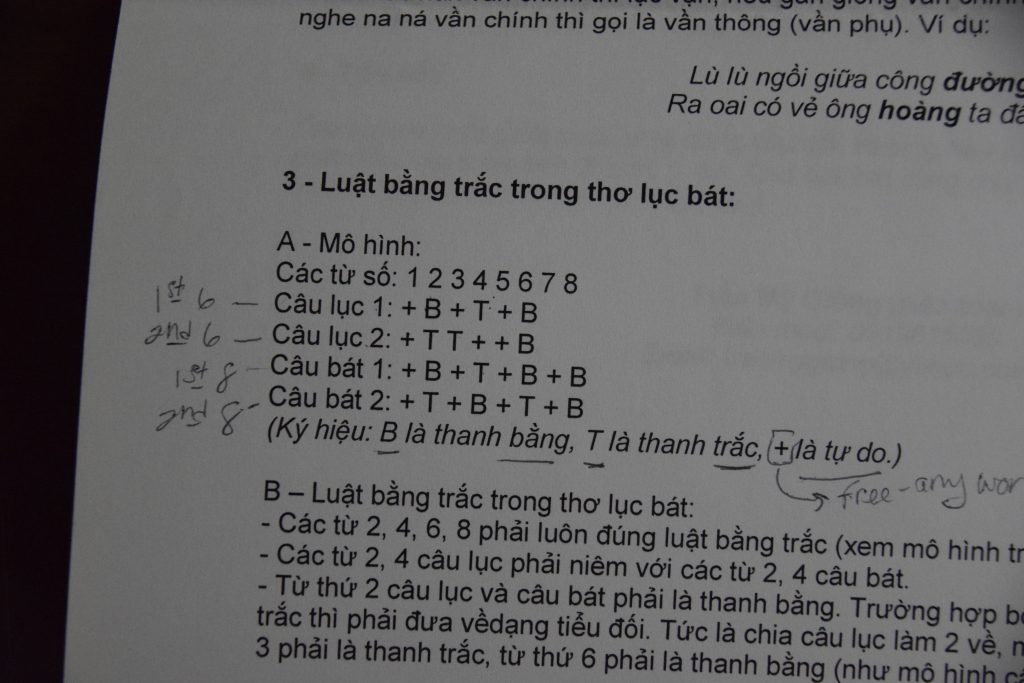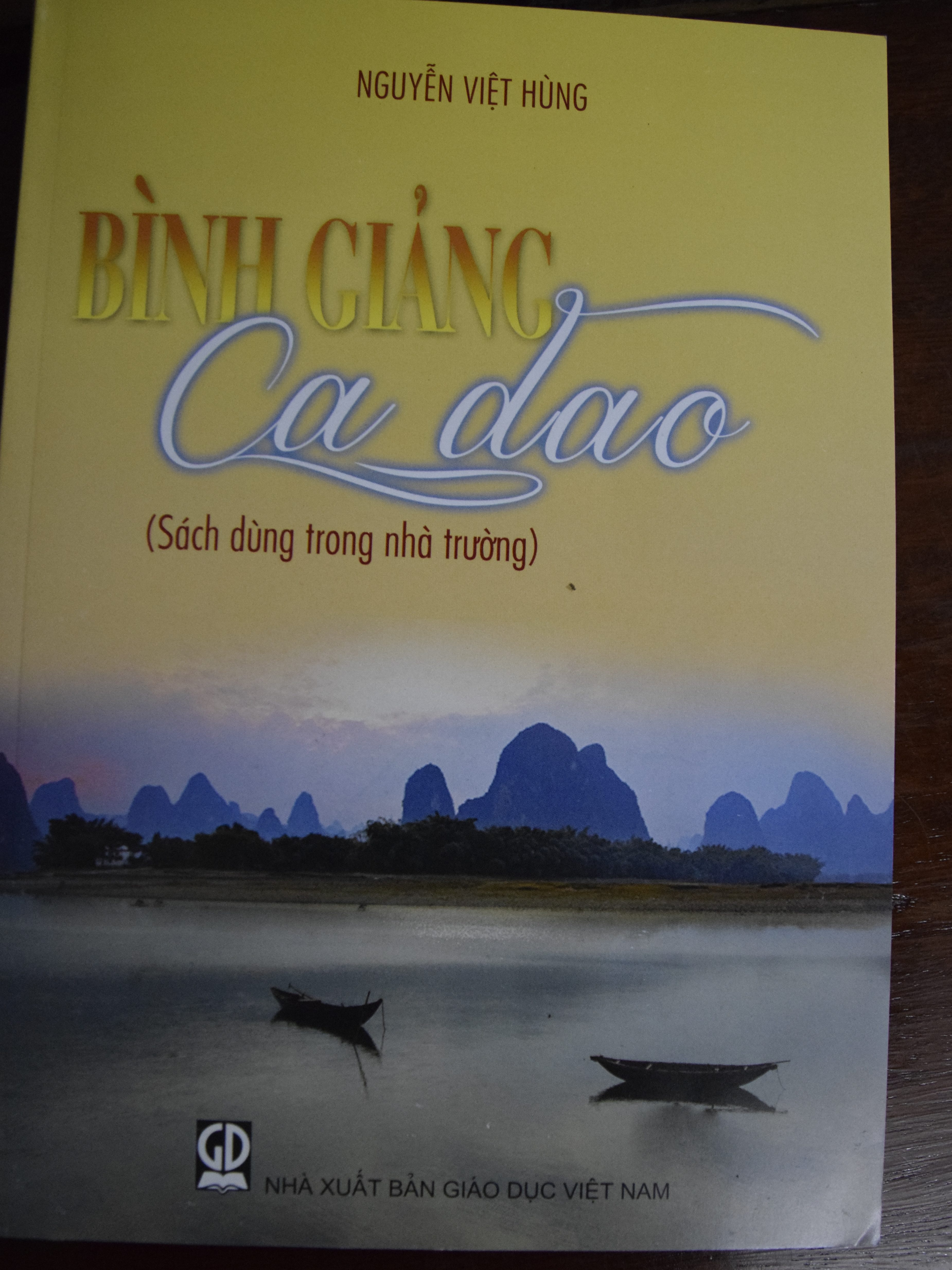Learning Luc Bat
“Luc bat” is a traditional form of Vietnamese poetry that I have been researching. I chose to study this as one of the things I could bring back to my students in the US when I teach them about Vietnam.
Luc bat has alternating lines of six and eight syllables and a specific rhyme scheme. At first, it seemed pretty straightforward. After attending lectures about this poetry form, interviewing students, doing independent research and trying to write in a luc bat style, I have begun to grasp just how complex it really is.
Besides the rhyming and syllable patterns, there is also a pattern of tones in luc bat. The six tones in Vietnamese are grouped into categories and traditional luc bat poetry follows a strict pattern of tones for nearly every word in every line. This adds to the rhythm and beauty of the poem in Vietnamese but makes it something that cannot be accurately translated into English.
To give an idea of the complexity of luc bat, here is an image showing the tone patterns. Each line has a specific pattern depending on where it falls in the poem.

The parts of luc bat that can be “copied” are the syllable patterns (alternating lines of six and eight syllables) and the rhyme scheme. Rhyming, however, is not simple in luc bat, and rhymes don’t always fall at the ends of lines, as you can see from this diagram. Each character represents a syllable.
xxxxxA
xxxxxAxB
xxxxxB
xxxxxBxC
xxxxxC
xxxxxCxD
xxxxxD
xxxxxDxE
On top of that, there are “rich” rhymes and “poor” rhymes in Vietnamese which figure into the patterns. The good news is that luc bat can be about any topic and have any number of lines.
Tale of Kiều
The most famous luc bat poem in Vietnamese is the Tale of Kiều. It was written by Nguyễn Du (1766–1820) and its influence and popularity are still prevalent today.
Luc bat is a form of poetry for the masses in Vietnam. It is popular and understood by all classes of people. There are references to the Tale of Kiều in everyday life, and people draw inspiration for their own lives from this timeless story. This description from an article on the Vietnam News Agency website describes the story and its significance.
Depicting the arduous life of Thuy Kieu, a beautiful and talented young woman who had to sell herself into prostitution to save her father from prison, Nguyen Du overcame harsh social prejudice to praise Kieu’s physical and soulful beauty, as well as her talents and personality.
Through Kieu’s story, the author wanted to draw a picture of the corrupt, money-dominated, evil and unequal feudal society in Vietnam in the late 18th century and the early 19th century, while reflecting the aspirations for the right to live, and the right to freedom, justice, love and happiness.
An Arduous Task
I tried writing my own English version of luc bat, and the rhyming pattern alone boggled my mind. I show it here only as an example for those of us who don’t speak Vietnamese. Please understand, though, that without the tone patterns that occur in Vietnamese, it is not even close to a representation of a real luc bat poem. I have color-coded the rhyming words to show the pattern.
It’s easy, so it seems
I’m told that luc bat means six eight
Just how long could it take?
Count the syllables, make a rhyme
I’ll be done in no time
Readers will know that I’m first-rate
Just a minute, please wait
Secrets do await those who
Are patient and construe
That the tone is the glue that makes
Each line dance like snowflakes
Writing this, my mind aches to think
As I approach the brink
Luc bat, I cannot drink from your streams.
These 14 lines took about two and a half hours to write, and I had to cheat in the last line by using nine syllables. Imagine writing 3254 lines (the length of the Tale of Kiều) following all of the luc bat rhyme, syllable and tone patterns!






January 4, 2017 @ 06:17
Bravo, Tim! Happy New Year!
January 10, 2017 @ 08:40
Thanks, Lori!
January 4, 2017 @ 08:08
Wow TIM you really amaze me! I have been trying to catch up on your blog and all the poems the students have written I hope to leave some comments this weekend they really did an outstanding job on their poems to this day I can’t write a poem. I don’t know if you know this but in grade school I had a speech teacher she reminded me of the old lady in the Tweety Bird cartoons she would have me read the seashells rhyme all the time as she would fall asleep I think this compounded my lack of confidence in language. Take care! Love Anne
January 10, 2017 @ 08:42
Maybe I’ll give a class at one of your horseshoe parties when I return!
January 4, 2017 @ 08:18
Um, I would have a hard time with this! Hats off to you 🙂
January 10, 2017 @ 08:43
I saw a speaker just rattle off lines spontaneously in luc bat form. I don’t know how they do it.
January 4, 2017 @ 12:34
Always impressive: cheers for Tim!
January 10, 2017 @ 08:43
Thank you, Susanne!
January 4, 2017 @ 22:21
Wow, interesting, complex and Tim – very impressive!
January 10, 2017 @ 08:44
Thanks, Marina. Hope you’re settling in well back at home.
January 5, 2017 @ 16:52
Boggles my mind! I think I would enjoy the story, “The tale of Kieu”. I like the poem and see how hard it would be to get the tone just right – what a fascinating type of poetry. Keep studying Tim.
January 10, 2017 @ 08:44
Thanks, Linda. It is an interesting story. The more I hear, the more I like.
January 6, 2017 @ 19:12
So much effort to meet all the criteria for this type of poem, and without the tonality. I enjoyed your poem, sorry it gave you a headache. Happy New Year Tim, stay safe.
Diane
January 10, 2017 @ 08:45
Happy New Year, Diane!
January 10, 2017 @ 17:15
This is amazing and seems like math and poetry combined. Not my cup of tea, but I could see some students LOVING it! Hope all is well for you and that 2017 is bringing you many more exciting adventures. Your students are going to be so lucky to have you when you return!!!
January 14, 2017 @ 06:35
🙂